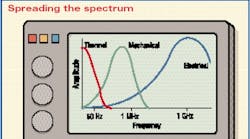Raw sensor signals may seem unintelligible, but a simple law of physics can help expose hidden information. The law, called superposition, states that the response (output signal) of a linear circuit (sensor) having several independent sources (stimuli) is the sum of the responses of the sources acting alone. In other words, raw sensor signals are actually the combination of many signals, stemming from electrical, mechanical, and temperature-related influences as well as the measurand itself.
Isolating the desired component from the rest of the signal is aided by the fact that thermal, mechanical, and electrical dynamics are vastly different. Spurious electrical response, for example, tends to reside high in the frequency spectrum. Common causes include switching transients, interference, and noise; the solution is a low-pass filter.
Thermal effects usually appear on the opposite end of the spectrum. They like to hide between 0 and 100 Hz. If the desired mechanical response is above this range, the best thing is a high-pass filter with a crossover frequency set as high as possible.
Sometimes problem signals are mechanically induced by forces such as shock, vibration, or acceleration. Usually occurring at frequencies between 0 and 2 MHz, these noise components usually present more of a challenge. A notch filter is one solution, but a good damping or vibration-isolation system is likely to be more effective.
Questions & Answers
Q: What determines mechanical response?
A: Construction mainly. In general, the greater the moving mass, the slower the mechanical response. Transducers having low stiffness and considerable play also tend to respond slowly.
Q: When are thermal and mechanical responses likely to overlap?
A: The problem is most common in sensors designed for high-speed mechanical events. Features that make sensors fast — small mass and stiff, tightly coupled components — make them thermally sensitive as well.
Q: How can I tell a thermal from a mechanical effect?
A: The best test is to apply a mild thermal shock to the sensor and observe the output for changes. If responses overlap, try putting an insulator around the sensor. The added thermal inertia may pull the temperature signal to a lower frequency, where it can be filtered more easily.

